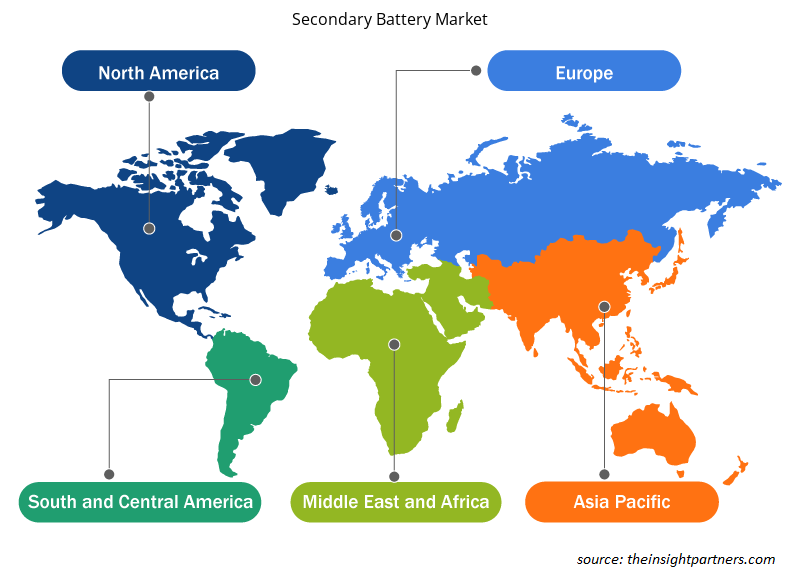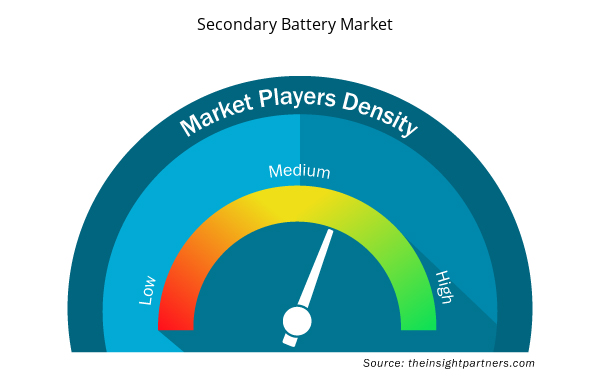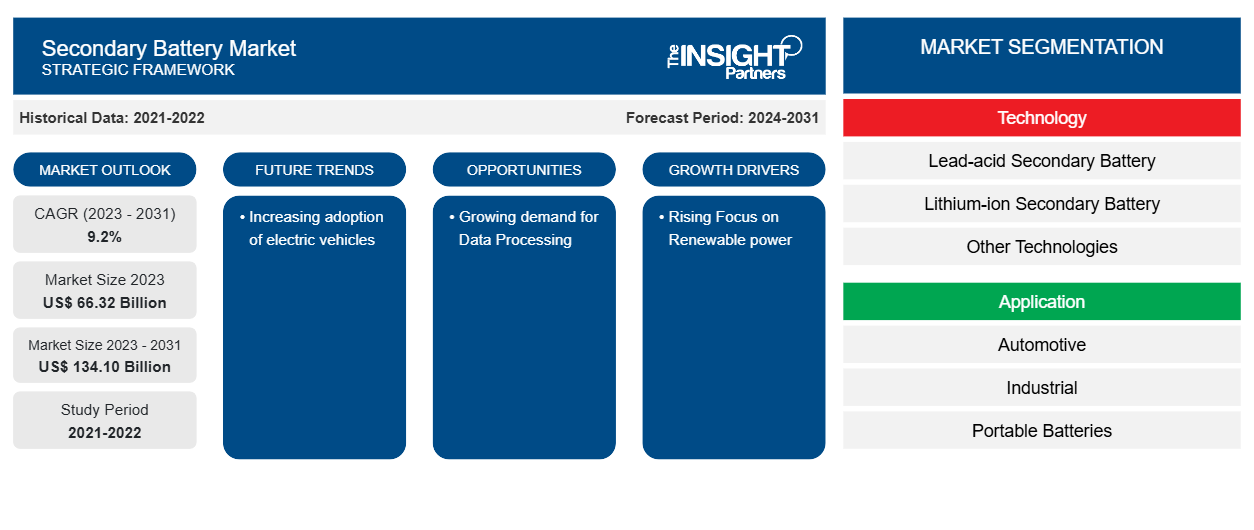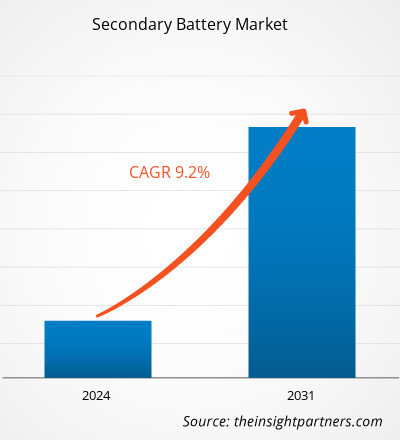Der globale Markt für Sekundärbatterien wird voraussichtlich von 66,32 Milliarden US-Dollar im Jahr 2023 auf 134,10 Milliarden US-Dollar im Jahr 2031 wachsen; von 2024 bis 2031 wird eine durchschnittliche jährliche Wachstumsrate von 9,2 % erwartet. Die zunehmende Verbreitung von Elektrofahrzeugen wird voraussichtlich ein wichtiger Trend auf dem Sekundärbatteriemarkt bleiben.
Sekundärbatterie-Marktanalyse
Das Wachstum des globalen Marktes ist auf Faktoren wie den technologischen Fortschritt, einen Aufschwung in den Endverbraucherbranchen und die politische Unterstützung der Regierung zur Förderung der Energiespeicherinfrastruktur zurückzuführen.
Sekundärbatterie-Marktübersicht
Ein wiederaufladbarer Akkumulator, eine Speicherbatterie oder eine Sekundärzelle (offiziell als Energiespeicher bekannt) ist eine Art von elektrischer Batterie, die geladen, in eine Last entladen und mehrmals wieder aufgeladen werden kann, im Gegensatz zu einer Einweg- oder Hauptbatterie, die vollständig geladen geliefert und nach Gebrauch entsorgt wird. Er besteht aus einer oder mehreren elektrochemischen Zellen. Der Begriff „Akkumulator“ bezieht sich auf etwas, das Energie über einen reversiblen elektrochemischen Prozess sammelt und speichert. Wiederaufladbare Batterien gibt es in verschiedenen Formen und Kapazitäten, von Knopfzellen bis hin zu Megawattsystemen, die zur Stabilisierung eines Stromverteilungsnetzes verwendet werden. Es werden verschiedene Elektrodenmaterialien und Elektrolyte verwendet, darunter Blei-Säure, Zink-Luft, Nickel-Cadmium (NiCd), Nickel-Metallhydrid (NiMH), Lithium-Ionen (Li-Ionen), Lithium-Eisenphosphat (LiFePO4) und Lithium-Ionen-Polymer.
Passen Sie diesen Bericht Ihren Anforderungen an
Sie erhalten kostenlos individuelle Anpassungen an jedem Bericht, einschließlich Teilen dieses Berichts oder einer Analyse auf Länderebene, eines Excel-Datenpakets sowie tolle Angebote und Rabatte für Start-ups und Universitäten.
- Holen Sie sich die wichtigsten Markttrends aus diesem Bericht.Dieses KOSTENLOSE Beispiel umfasst eine Datenanalyse von Markttrends bis hin zu Schätzungen und Prognosen.
Treiber und Chancen auf dem Sekundärbatteriemarkt
Zunehmender Fokus auf erneuerbare Energien begünstigt den Markt
Die Erzeugung erneuerbarer Energien wird weltweit immer beliebter. Deutschland und Frankreich sind Vorreiter bei der Nutzung erneuerbarer Energien. Allerdings sind diese Länder weiterhin auf Netto-Stromimporte angewiesen. Schwellenländer hingegen setzen auf erneuerbare Energien, werden aber aufgrund ihres steigenden Energieverbrauchs und ihrer unzureichenden Netzinfrastruktur zu Netto-Stromimporteuren. Dieser Umstand unterstreicht die Notwendigkeit von Energiespeichertechnologien, insbesondere Sekundärbatterien , um eine stabile Stromversorgung zu gewährleisten. Daher wird erwartet, dass der weltweite Markt für Sekundärbatterien in den kommenden Jahren erheblich wachsen wird.
Wachsende Nachfrage nach Datenverarbeitung
Die wachsende Nachfrage nach Datenverarbeitung treibt tatsächlich die Nachfrage nach dem Sekundärbatteriemarkt an. Dies ist auf mehrere Faktoren zurückzuführen, darunter technologische Fortschritte, die steigende Nachfrage nach tragbaren elektronischen Geräten und die Umstellung auf erneuerbare Energiequellen. Die Nachfrage nach Sekundärbatterien wird durch technologische Fortschritte und die steigende Nachfrage nach tragbaren elektronischen Geräten wie Smartphones, Tablets und tragbaren Geräten angetrieben. Diese Geräte benötigen zuverlässige und effiziente Stromquellen, und Sekundärbatterien bieten die notwendige Energiespeicherung.fuelling the demand for the secondary battery market. This is due to several factors, including technological advancements, increasing demand for portable electronics, and the shift towards renewable energy sources. The demand for secondary batteries is driven by technological advancements and the increasing demand for portable electronics such as smartphones, tablets, and wearable devices. These devices require reliable and efficient power sources, and secondary batteries provide the necessary energy storage.
Segmentierungsanalyse des Sekundärbatteriemarktberichts
Schlüsselsegmente, die zur Ableitung der Technologie und Anwendung der Marktanalyse für Sekundärbatterien beigetragen haben.
- Basierend auf der Technologie ist der Markt in Blei-Säure-Sekundärbatterien, Lithium-Ionen-Sekundärbatterien und andere Technologien unterteilt. Das Segment der Blei-Säure-Sekundärbatterien hatte im Jahr 2023 einen größeren Marktanteil.
- Je nach Anwendung ist der Markt in Automobil-, Industrie-, tragbare Batterien-, Medizingeräte-, Gabelstapler- und andere Anwendungen unterteilt. Das Industriesegment hatte im Jahr 2023 einen größeren Marktanteil.
Sekundärbatterie-Marktanteilsanalyse nach Geografie
Der geografische Umfang des Berichts zum Sekundärbatteriemarkt ist hauptsächlich in fünf Regionen unterteilt: Nordamerika, Asien-Pazifik, Europa, Naher Osten und Afrika sowie Südamerika/Süd- und Mittelamerika. Nordamerika dominierte den Sekundärbatteriemarkt im Jahr 2023. Der Batteriemarkt in der nordamerikanischen Region, zu der die Vereinigten Staaten, Kanada und Mexiko gehören, verzeichnet aufgrund von Faktoren wie einem starken Fokus auf nachhaltige Entwicklung und einem gestiegenen Bewusstsein für die negativen Auswirkungen traditioneller Automobile ein erhebliches Wachstum. Die steigende globale Umweltverschmutzung und die abnehmende Verfügbarkeit fossiler Brennstoffe haben eine Nachfrage nach umweltfreundlichen Transportlösungen geschaffen. Als Reaktion auf diese Bedenken setzen Automobilhersteller fortschrittliche Technologien ein und integrieren Lithium-Ionen-Batterien in Hybrid- und Elektrofahrzeuge (EVs), um dem dringenden Bedarf an Umweltschutz gerecht zu werden.
Regionale Einblicke in den Sekundärbatteriemarkt
Die regionalen Trends und Faktoren, die den Sekundärbatteriemarkt während des Prognosezeitraums beeinflussen, wurden von den Analysten von Insight Partners ausführlich erläutert. In diesem Abschnitt werden auch Sekundärbatteriemarktsegmente und -geografie in Nordamerika, Europa, im asiatisch-pazifischen Raum, im Nahen Osten und Afrika sowie in Süd- und Mittelamerika erörtert.

- Erhalten Sie regionale Daten zum Sekundärbatteriemarkt
Umfang des Marktberichts für Sekundärbatterien
| Berichtsattribut | Details |
|---|---|
| Marktgröße im Jahr 2023 | 66,32 Milliarden US-Dollar |
| Marktgröße bis 2031 | 134,10 Milliarden US-Dollar |
| Globale CAGR (2023 - 2031) | 9,2 % |
| Historische Daten | 2021-2022 |
| Prognosezeitraum | 2024–2031 |
| Abgedeckte Segmente | Nach Technologie
|
| Abgedeckte Regionen und Länder | Nordamerika
|
| Marktführer und wichtige Unternehmensprofile |
|
Marktteilnehmerdichte: Der Einfluss auf die Geschäftsdynamik
Der Markt für Sekundärbatterien wächst rasant, angetrieben durch die steigende Nachfrage der Endnutzer aufgrund von Faktoren wie sich entwickelnden Verbraucherpräferenzen, technologischen Fortschritten und einem größeren Bewusstsein für die Vorteile des Produkts. Mit der steigenden Nachfrage erweitern Unternehmen ihr Angebot, entwickeln Innovationen, um die Bedürfnisse der Verbraucher zu erfüllen, und nutzen neue Trends, was das Marktwachstum weiter ankurbelt.
Die Marktteilnehmerdichte bezieht sich auf die Verteilung von Firmen oder Unternehmen, die in einem bestimmten Markt oder einer bestimmten Branche tätig sind. Sie gibt an, wie viele Wettbewerber (Marktteilnehmer) in einem bestimmten Marktraum im Verhältnis zu seiner Größe oder seinem gesamten Marktwert präsent sind.
Die wichtigsten auf dem Sekundärbatteriemarkt tätigen Unternehmen sind:
- Amperex Technology Limited
- BYD Company Ltd
- Duracell Inc
- EnerSys
- Contemporary Amperex Technology Co. Limited
- Panasonic Corporation
Haftungsausschluss : Die oben aufgeführten Unternehmen sind nicht in einer bestimmten Reihenfolge aufgeführt.

- Überblick über die wichtigsten Akteure auf dem Sekundärbatteriemarkt
Neuigkeiten und aktuelle Entwicklungen zum Sekundärbatteriemarkt
Der Sekundärbatteriemarkt wird durch die Erhebung qualitativer und quantitativer Daten nach Primär- und Sekundärforschung bewertet, die wichtige Unternehmensveröffentlichungen, Verbandsdaten und Datenbanken einschließt. Im Folgenden finden Sie eine Liste der Entwicklungen auf dem Markt:
- Im April 2024 wird der chinesische Autohersteller BYD im August 2024 seinen „Blade“-Akkupack der zweiten Generation vorstellen. Diese neue Akkutechnologie soll eine ausreichende Reichweite haben, um ein Elektroauto mit einer einzigen Ladung von Sydney nach Melbourne zu fahren. Der Blade-Akkupack der zweiten Generation wird auf BYDs proprietärer Lithium-Ionen-Phosphat-Akkutechnologie (LFP) basieren. Es ist erwähnenswert, dass diese Technologie die Einführung von Festkörperbatterien mit einer ähnlichen Reichweite durch Toyota übertreffen wird, die derzeit frühestens für 2026 geplant ist.
(Quelle: BYD, Pressemitteilung, 2024)
Marktbericht für Sekundärbatterien – Abdeckung und Ergebnisse
Der Bericht „Marktgröße und Prognose für Sekundärbatterien (2021–2031)“ bietet eine detaillierte Analyse des Marktes, die die folgenden Bereiche abdeckt:
- Marktgröße und Prognose auf globaler, regionaler und Länderebene für alle wichtigen Marktsegmente, die im Rahmen des Projekts abgedeckt sind
- Marktdynamik wie Treiber, Beschränkungen und wichtige Chancen
- Wichtige Zukunftstrends
- Detaillierte PEST/Porters Five Forces- und SWOT-Analyse
- Globale und regionale Marktanalyse mit wichtigen Markttrends, wichtigen Akteuren, Vorschriften und aktuellen Marktentwicklungen
- Branchenlandschaft und Wettbewerbsanalyse, einschließlich Marktkonzentration, Heatmap-Analyse, prominenten Akteuren und aktuellen Entwicklungen
- Detaillierte Firmenprofile
- Historische Analyse (2 Jahre), Basisjahr, Prognose (7 Jahre) mit CAGR
- PEST- und SWOT-Analyse
- Marktgröße Wert/Volumen – Global, Regional, Land
- Branche und Wettbewerbsumfeld
- Excel-Datensatz



Report Coverage
Revenue forecast, Company Analysis, Industry landscape, Growth factors, and Trends

Segment Covered
This text is related
to segments covered.

Regional Scope
North America, Europe, Asia Pacific, Middle East & Africa, South & Central America

Country Scope
This text is related
to country scope.
Häufig gestellte Fragen
The secondary battery market size is expected to grow from US$ 66.32 billion in 2023 to US$ 134.10 billion by 2031; it is anticipated to expand at a CAGR of 9.2% from 2024 to 2031.
The growth of the global market can be attributed to several factors that have contributed to its expansion. These factors include technological advancements, a surge in end-user industries, and government policy-level support to promote energy storage infrastructure.
The increasing adoption of electric vehicles is likely to remain a key secondary battery market trends.
The key players holding the majority of shares in the global secondary battery are Panasonic Corporation, SaftGroupe SA, Samsung SDI Co., Ltd., GS Yuasa International Ltd., and LG Chem.
The global secondary battery market is expected to reach US$ 134.10 billion by 2031.
Trends and growth analysis reports related to Electronics and Semiconductor : READ MORE..
The Insight Partners performs research in 4 major stages: Data Collection & Secondary Research, Primary Research, Data Analysis and Data Triangulation & Final Review.
- Data Collection and Secondary Research:
As a market research and consulting firm operating from a decade, we have published and advised several client across the globe. First step for any study will start with an assessment of currently available data and insights from existing reports. Further, historical and current market information is collected from Investor Presentations, Annual Reports, SEC Filings, etc., and other information related to company’s performance and market positioning are gathered from Paid Databases (Factiva, Hoovers, and Reuters) and various other publications available in public domain.
Several associations trade associates, technical forums, institutes, societies and organization are accessed to gain technical as well as market related insights through their publications such as research papers, blogs and press releases related to the studies are referred to get cues about the market. Further, white papers, journals, magazines, and other news articles published in last 3 years are scrutinized and analyzed to understand the current market trends.
- Primary Research:
The primarily interview analysis comprise of data obtained from industry participants interview and answers to survey questions gathered by in-house primary team.
For primary research, interviews are conducted with industry experts/CEOs/Marketing Managers/VPs/Subject Matter Experts from both demand and supply side to get a 360-degree view of the market. The primary team conducts several interviews based on the complexity of the markets to understand the various market trends and dynamics which makes research more credible and precise.
A typical research interview fulfils the following functions:
- Provides first-hand information on the market size, market trends, growth trends, competitive landscape, and outlook
- Validates and strengthens in-house secondary research findings
- Develops the analysis team’s expertise and market understanding
Primary research involves email interactions and telephone interviews for each market, category, segment, and sub-segment across geographies. The participants who typically take part in such a process include, but are not limited to:
- Industry participants: VPs, business development managers, market intelligence managers and national sales managers
- Outside experts: Valuation experts, research analysts and key opinion leaders specializing in the electronics and semiconductor industry.
Below is the breakup of our primary respondents by company, designation, and region:

Once we receive the confirmation from primary research sources or primary respondents, we finalize the base year market estimation and forecast the data as per the macroeconomic and microeconomic factors assessed during data collection.
- Data Analysis:
Once data is validated through both secondary as well as primary respondents, we finalize the market estimations by hypothesis formulation and factor analysis at regional and country level.
- Macro-Economic Factor Analysis:
We analyse macroeconomic indicators such the gross domestic product (GDP), increase in the demand for goods and services across industries, technological advancement, regional economic growth, governmental policies, the influence of COVID-19, PEST analysis, and other aspects. This analysis aids in setting benchmarks for various nations/regions and approximating market splits. Additionally, the general trend of the aforementioned components aid in determining the market's development possibilities.
- Country Level Data:
Various factors that are especially aligned to the country are taken into account to determine the market size for a certain area and country, including the presence of vendors, such as headquarters and offices, the country's GDP, demand patterns, and industry growth. To comprehend the market dynamics for the nation, a number of growth variables, inhibitors, application areas, and current market trends are researched. The aforementioned elements aid in determining the country's overall market's growth potential.
- Company Profile:
The “Table of Contents” is formulated by listing and analyzing more than 25 - 30 companies operating in the market ecosystem across geographies. However, we profile only 10 companies as a standard practice in our syndicate reports. These 10 companies comprise leading, emerging, and regional players. Nonetheless, our analysis is not restricted to the 10 listed companies, we also analyze other companies present in the market to develop a holistic view and understand the prevailing trends. The “Company Profiles” section in the report covers key facts, business description, products & services, financial information, SWOT analysis, and key developments. The financial information presented is extracted from the annual reports and official documents of the publicly listed companies. Upon collecting the information for the sections of respective companies, we verify them via various primary sources and then compile the data in respective company profiles. The company level information helps us in deriving the base number as well as in forecasting the market size.
- Developing Base Number:
Aggregation of sales statistics (2020-2022) and macro-economic factor, and other secondary and primary research insights are utilized to arrive at base number and related market shares for 2022. The data gaps are identified in this step and relevant market data is analyzed, collected from paid primary interviews or databases. On finalizing the base year market size, forecasts are developed on the basis of macro-economic, industry and market growth factors and company level analysis.
- Data Triangulation and Final Review:
The market findings and base year market size calculations are validated from supply as well as demand side. Demand side validations are based on macro-economic factor analysis and benchmarks for respective regions and countries. In case of supply side validations, revenues of major companies are estimated (in case not available) based on industry benchmark, approximate number of employees, product portfolio, and primary interviews revenues are gathered. Further revenue from target product/service segment is assessed to avoid overshooting of market statistics. In case of heavy deviations between supply and demand side values, all thes steps are repeated to achieve synchronization.
We follow an iterative model, wherein we share our research findings with Subject Matter Experts (SME’s) and Key Opinion Leaders (KOLs) until consensus view of the market is not formulated – this model negates any drastic deviation in the opinions of experts. Only validated and universally acceptable research findings are quoted in our reports.
We have important check points that we use to validate our research findings – which we call – data triangulation, where we validate the information, we generate from secondary sources with primary interviews and then we re-validate with our internal data bases and Subject matter experts. This comprehensive model enables us to deliver high quality, reliable data in shortest possible time.


 Holen Sie sich ein kostenloses Muster für diesen Bericht
Holen Sie sich ein kostenloses Muster für diesen Bericht